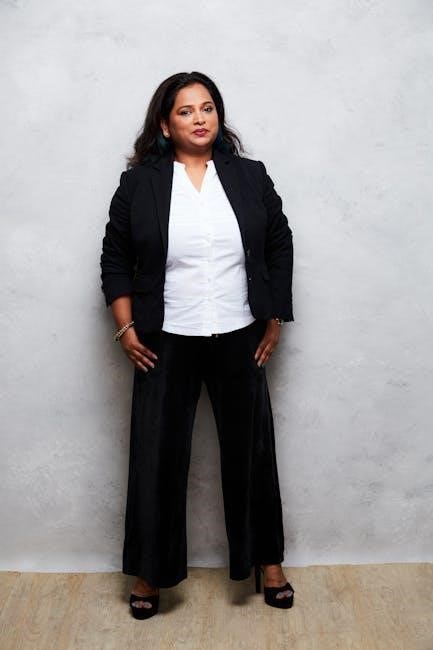Understanding the perfect jacket length is crucial for a tailored appearance․ This guide helps explore key considerations, ensuring a proper fit and style․ Learn how body type and shoulder fit influence your jacket choice for confidence and comfort․
1․1 Importance of Proper Jacket Length
A well-fitted suit jacket is essential for creating a polished and professional appearance․ Proper jacket length ensures balance and proportion, enhancing both style and comfort․ A jacket that is too long can overwhelm the frame, while one that is too short may appear ill-fitting․ The right length complements the wearer’s body type and ensures that other features, such as sleeve length and shoulder fit, align harmoniously․ Additionally, proper jacket length impacts posture and confidence, as a tailored fit creates a sharp, streamlined silhouette․ Paying attention to these details ensures the jacket looks intentional and well-crafted, making it a cornerstone of a sophisticated wardrobe․ A little attention to this aspect can elevate the entire outfit, ensuring a flattering and professional look․
1․2 Brief Overview of Key Considerations
When determining the ideal suit jacket length, several factors come into play․ Proper shoulder fit is non-negotiable, as it sets the foundation for the entire garment․ Sleeve length should reveal about 1/4 inch of shirt cuff, ensuring balance and proportion․ Body type plays a significant role, with shorter men often favoring shorter jackets and taller individuals opting for longer styles․ Additionally, the jacket’s closure and button placement should complement the wearer’s torso length․ Current trends may influence choices, such as modern slim fits or classic longer styles․ Seasonal variations, like lighter fabrics for summer, also impact length preferences․ Ultimately, the goal is to achieve a harmonious blend of fit, comfort, and personal style․
Understanding Jacket Length Measurements

Accurate measurements are essential for a balanced fit․ Key considerations include shoulder-to-cuff length and jacket length relative to body proportions and shirt sleeve visibility for a polished look․
2․1 Standard Jacket Length Sizes
Standard jacket length sizes vary based on style and fit preferences․ Slim-fit jackets are shorter, often designed for a more modern look, while classic or relaxed styles are longer for a traditional appearance․ Generally, jacket lengths range from 29 inches for shorter fits to 32 inches for longer, classic styles․ These measurements are typically taken from the base of the collar to the hem․ Sleeve length is also a critical factor, with the cuff ideally showing 1/4 inch of shirt sleeve․ Proper fit ensures balance and proportion, making it essential to choose a length that complements your body type․ Understanding these standards helps in selecting a jacket that aligns with your style and comfort needs․
2․2 How to Measure Jacket Length Correctly
To measure jacket length accurately, stand upright and place the tape measure at the base of your neck, just below the collarbone․ Gently extend it down to the desired jacket length, ensuring the tape is straight and not twisted․ For most suits, the length typically ranges from 29 to 32 inches, depending on your height and build․ The jacket should cover your hips but not extend beyond them for a balanced look․ Always measure while wearing a dress shirt to ensure proper fit․ Natural posture and fabric type can slightly affect the final measurement, so consider these factors for the best results․
Factors Influencing Jacket Length
Your body type and proportions play a significant role in determining the ideal jacket length․ Shoulder fit and overall tailoring are also critical for achieving a balanced, polished look․

3․1 Body Type and Proportions

Your body type significantly impacts the ideal suit jacket length․ For shorter men, a shorter jacket creates proportion, while taller individuals can opt for longer styles․ Broader builds benefit from slightly longer jackets to balance proportions․ Slimmer individuals should avoid overly long jackets to maintain a streamlined look․ Ensure the jacket Skims your torso without restricting movement․ Proper fit enhances confidence and comfort, making it essential to tailor the jacket to your specific body type․ Proportions are key to achieving a polished, professional appearance, ensuring the jacket complements your natural frame․ Always consider your body type when selecting jacket length for the most flattering fit․
3․2 Shoulder Fit and Its Impact
The shoulder fit is a critical factor in determining the overall appearance of a suit jacket․ A well-fitting shoulder ensures the jacket sits naturally, enhancing posture and confidence․ Ill-fitting shoulders, whether too tight or too loose, can disrupt the balance of the garment; For broader shoulders, structured padding provides support and definition, while softer shoulders suit slimmer frames․ Proper shoulder fit also impacts comfort, as tight shoulders can restrict movement․ Ensuring the shoulder measurement aligns with your body is essential, as alterations in this area are often limited․ A correctly fitted shoulder creates a polished look, making it a primary consideration when selecting or tailoring a jacket․

Sleeve Length and Jacket Fit
Sleeve length should reveal a hint of shirt cuff for a balanced look․ Proper fit ensures style and comfort, with cuffs aligning perfectly and enhancing overall jacket fit․
4․1 Ideal Sleeve Length for Different Builds
The ideal sleeve length varies based on body type and proportions․ For shorter men, sleeves should be proportionally shorter to avoid overwhelming the frame, while taller individuals can opt for slightly longer sleeves․ A general rule is to ensure the sleeve ends just above the wrist bone, allowing a subtle glimpse of the shirt cuff—about 1/4 inch of shirt sleeve should be visible․ This balance ensures a polished look while maintaining comfort․ For broader builds, slightly longer sleeves can create a more balanced silhouette, whereas slim builds benefit from tailored, shorter sleeves․ Proper sleeve length enhances overall fit, ensuring the jacket looks tailored rather than ill-fitting․ Achieving this balance is key to a sharp, confident appearance․
4․2 How Sleeve Length Affects Overall Fit
Proper sleeve length is essential for a polished and balanced look․ Sleeves that are too long can overwhelm the frame, while those that are too short may appear disproportionate; The ideal length allows a slight visibility of the shirt cuff, typically about 1/4 inch, ensuring harmony between the jacket and shirt․ This subtle detail enhances both aesthetic appeal and functionality, as it prevents the sleeves from restricting movement or looking overly bulky․ Correct sleeve length also draws the eye upward, creating a lengthening effect on the torso․ Ultimately, it ensures the jacket sits naturally on the shoulders, contributing to a sharp, tailored appearance․

Jacket Length Trends and Styles
Modern jackets often feature shorter lengths for a sleek look, while classic styles remain timeless with traditional cuts․ Seasonal trends may influence length for practicality and fashion․
5․1 Modern vs․ Classic Jacket Lengths
Modern and classic jacket lengths reflect evolving fashion trends while catering to different aesthetics․ Modern jackets often feature a slim-fit design with shorter lengths, emphasizing a contemporary and streamlined look․ These jackets typically hit just above the hip, creating a stylish yet usable silhouette․ In contrast, classic jackets are slightly longer, often reaching the mid-to-low hip area, offering a timeless and elegant appearance․ The choice between the two depends on personal style, body type, and the desired formality․ Modern styles are ideal for slim builds and trend-forward wardrobes, while classic lengths suit those seeking versatility and a traditional look․ Both styles ensure a polished finish when paired with complementary trousers and accessories․ Understanding these distinctions helps in selecting the perfect jacket for any occasion․
5․2 Seasonal Variations in Jacket Length
Seasonal variations influence jacket length trends, with warmer months favoring shorter styles and cooler seasons opting for longer designs․ Summer jackets often feature a cropped or semi-fitted silhouette, emphasizing comfort and breathability․ In contrast, winter jackets tend to be longer, providing additional coverage and warmth․ Spring and fall collections often blend these elements, offering versatile lengths that suit transitional weather․ These seasonal adjustments not only reflect practical needs but also align with fashion trends, ensuring a stylish and functional approach to tailoring․ By adapting jacket length to the season, individuals can maintain a polished look while addressing climate-specific requirements․ This balance between aesthetics and utility makes seasonal variations a key consideration in choosing the right jacket length․
A well-fitted suit jacket is essential for confidence and style․ Mastering the perfect jacket length ensures a polished appearance, balancing proportions and comfort․ Whether modern or classic, understanding how body type, shoulder fit, and sleeve length interact is key․ Seasonal trends may influence designs, but proper measurements remain timeless․ Always prioritize a fit that complements your physique, ensuring the jacket sits naturally on your shoulders and sleeves reveal the right amount of shirt cuff․ By following these guidelines, you’ll achieve a tailored look that exudes professionalism and sophistication․ Remember, the right fit is the foundation of great style, making every occasion unforgettable․
